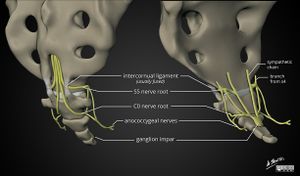Coccyx: Difference between revisions
No edit summary |
|||
| (11 intermediate revisions by the same user not shown) | |||
| Line 49: | Line 49: | ||
==Variant anatomy== | ==Variant anatomy== | ||
* | *Three, four, or five segments | ||
* | *Intercoccygeal segments can be complete intervertebral discs, partial discs, synovial joints, or they can be fused | ||
* | *Bifid coccyx | ||
* | *Hypoplasia or aplasia | ||
==Development== | ==Development== | ||
| Line 61: | Line 61: | ||
==See Also== | ==See Also== | ||
[[Coccydynia]] | *[[Coccydynia]] | ||
*[[Ganglion Impar Injection]] | |||
==References== | ==References== | ||
{{Article derivation|article=https://radiopaedia.org/articles/coccyx|license=CC BY-NC-SA 3.0|license-link=https://creativecommons.org/licenses/by-nc-sa/3.0/}} | {{Article derivation | ||
|article=Coccyx | |||
|article-link=https://radiopaedia.org/articles/coccyx | |||
|author=Dr Kieran Kusel and Dr Juliana K. Yee et al. | |||
|license=CC BY-NC-SA 3.0 | |||
|license-link=https://creativecommons.org/licenses/by-nc-sa/3.0/ | |||
}} | |||
[[Category:Sacrococcygeal Spine]] | [[Category:Sacrococcygeal Spine]] | ||
[[Category:Bones]] | |||
[[Category:Bones of the Spine]] | |||
Latest revision as of 17:27, 30 April 2022
The coccyx (plural: coccyges) is the series of rudimentary vertebrae forming the caudal termination of the vertebral column and is positioned inferior to the apex of the sacrum. The coccyx is one leg of the tripod formed in conjunction with the ischial tuberosities for support in a seated position. Additionally, it serves as the insertion site for the muscles of the pelvic floor and those that contribute to voluntary bowel control and supports the position of the anus.
Terminology
For the purposes of numbering the vertebral segments, "Co" is used as the abbreviation for each coccygeal level, e.g. Co1, Co2, etc. Clearly "C" is already used for the cervical vertebrae.
Gross anatomy
The coccyx is formed from four rudimentary vertebrae and does not contain a spinal canal, pedicles, laminae or spinous processes. The first segment is the largest, and the subsequent are smaller in size. Structure of the coccygeal vertebral junctions is variable and age-related, ranging from fully developed to rudimentary intervertebral discs with varying degrees of cystic or fibrotic change, to fusion of the vertebrae in the later decades.
The coccyx consists of an anterior and posterior surface, two lateral surfaces, an apex and a base.
- anterior surface: concave, marked with three transverse grooves representing the fusions of the four separate vertebrae
- posterior surface
- convex, similarly marked with three transverse grooves
- there is a vertical row of tubercles on either side, which are rudimentary articular processes of the coccygeal vertebrae
- the superior pair are the largest and are called the coccygeal cornua. They articulate with the sacral cornua
- the coccygeal and sacral cornua combine to form the foramen for the transmission of the posterior division of the fifth sacral nerve
- lateral surface
- thin with several eminences that represent rudimentary transverse processes of the coccygeal vertebrae
- the most superior eminences join the lateral edges of the sacrum, forming the foramen for the transmission of the anterior division of the fifth sacral nerve
- it is the largest eminence and the inferior eminences subsequently decrease in size
- anteriorly to posteriorly, the lateral border serves as attachment for the coccygeus, sacrospinous ligament, sacrotuberous ligament, and fibres of the gluteus maximus
- base: proximal oval surface for articulation with the sacrum
- apex: distal rounded prominence
Articulations
- Sacrococcygeal symphysis: a fibrocartilaginous joint that connects the apex of the sacrum to the coccyx. Movement is passive minor flexion and extension and the joint typically fuses with age
Attachments
- Ligamentous
Five ligaments support the sacrococcygeal symphysis:
- anterior sacrococcygeal ligament: continuation of the anterior longitudinal ligament - connects to the anterior aspect of the 1st and sometimes 2nd vertebral bodies
- deep posterior sacrococcygeal ligament: connects from the 5th sacral body to the dorsal surface of the coccyx
- superficial posterior sacrococcygeal ligament: begins on the medial sacral crest and inserts on the dorsal surface of the coccyx
- lateral sacrococcygeal ligament: joins the transverse process of the first coccygeal vertebra to the inferolateral angle of the sacrum. This completes the foramen for the fifth sacral nerve anteriorly. Posteriorly the foramen is closed by the sacral and coccygeal cornua connected by the intercornual ligament
- interarticular (intercornual) ligaments: connect the cornua of the sacrum to the cornua of the coccyx
- anococcygeal raphe: ligament that helps support the position of the anus
- Musculotendinous
- gluteus maximus: attaches to the lateral coccyx
- levator ani: attaches to the anterior border and the apex of the coccyx
- sphincter ani externus: attaches to the apex of the coccyx
Relations
- upper surface: pelvic floor
- lower surface: buttocks
Variant anatomy
- Three, four, or five segments
- Intercoccygeal segments can be complete intervertebral discs, partial discs, synovial joints, or they can be fused
- Bifid coccyx
- Hypoplasia or aplasia
Development
The coccyx arises from a caudal eminence present from weeks 4-8 of gestation. This caudal eminence regresses by birth, leaving the four precursor vertebrae. Ossification takes place from the centre of each precursor vertebra, with the cornua ossifying from separate centres. The first segment appears between ages one to four, the second between ages five to ten, the third between ten and fifteen years, and the fourth between fourteen and twenty years. Segments do not unite until after age twenty-five or thirty. The coccyx only fuses with sacrum late in life, and this occurs more prevalently with females than males.
History and etymology
The word coccyx is derived from the Greek word for “cuckoo” because of the similarity of its appearance to the cuckoo's beak when viewed from the side.
See Also
References
Part or all of this article or section is derived from Coccyx by Dr Kieran Kusel and Dr Juliana K. Yee et al., used under CC BY-NC-SA 3.0


